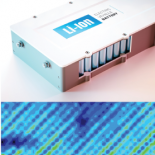Quantifying Expansions in a Lithium-Ion Battery Pack
 Figure 1: Display of changes within the battery pack casing, showing expansions from charging and discharging. The gray diamond shows how the center of force changed over time.
Figure 1: Display of changes within the battery pack casing, showing expansions from charging and discharging. The gray diamond shows how the center of force changed over time.
Challenge:
Lithium-ion batteries pack a lot of energy into a thin, lightweight container, making them a popular choice to power electronic vehicles. They can, however, pose safety hazards due to the effect of "thermal runaway" – a destructive scenario caused by overheating within such a small, high-energy density.
Solution:
When a lithium-ion battery is charged and discharged several times, the cell in the battery expands slightly. This causes the several small plates within the battery to get closer together, thus opening the chance of microscopic metal particles coming in contact, and causing a short circuit.
One automobile manufacturer developing a lithium-ion battery pack for an electric vehicle used pressure mapping technology to determine pressure level and distribution between the cells, stack, and housing, over several charges and discharges. Even after several days of testing, the pressure mapping system was able to capture evidence of these potentially hazardous expansions, which the manufacturer could use to improve their container design.
Similar Applications:
- EV battery design for solid state battery designs as well as lithium-ion
- Fuel cell stack design
- Engine gasket design